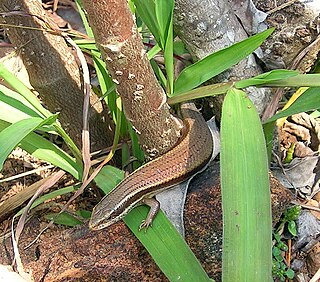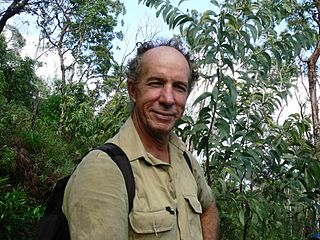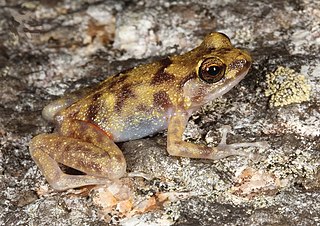
The Challenger expedition of 1872–1876 was a scientific programme that made many discoveries to lay the foundation of oceanography. The expedition was named after the naval vessel that undertook the trip, HMS Challenger.

Skinks are lizards belonging to the family Scincidae, a family in the infraorder Scincomorpha. With more than 1,500 described species across 100 different taxonomic genera, the family Scincidae is one of the most diverse families of lizards. Skinks are characterized by their smaller legs in comparison to typical lizards and are found in different habitats except arctic and subarctic regions.

Lygosominae is the largest subfamily of skinks in the family Scincidae. The subfamily can be divided into a number of genus groups. If the rarely used taxonomic rank of infrafamily is employed, the genus groups would be designated as such, but such a move would require a formal description according to the ICZN standards.

Lewis Roberts, OAM, is a distinguished naturalist and botanical illustrator. Lewis and his brother, Charlie Roberts, are probably the leading experts on the flora and fauna of south-eastern part Cape York Peninsula and the northern Wet Tropics area. For three generations his family has lived at Shipton's Flat, about 45 km south of Cooktown, where he and Charlie were home-schooled. His father, Jack Lewis, was a tin miner and self-taught naturalist.

Saproscincus mustelinus, commonly known as the southern weasel skink or weasel shadeskink, is a small species of skink which is endemic to Australia.

Saproscinus spectabilis known as the gully shadeskink is a small lizard found in Queensland and New South Wales, Australia. The habitat is cool, shaded gullies where it feeds on small insects. It may be seen on sunny rocky outcrops within gullies. Ground cover and rocky cracks are required to avoid predation from birds such as the kookaburra and pied currawong.
The Cape Melville shadeskink is a species of lizards from the Cape York Peninsula of Queensland, Australia, described in 2013. It was one of three vertebrates discovered by scientists from James Cook University and National Geographic in an area of mountain rainforest in North Queensland. The lizards are active by day, running and jumping through the mossy boulder fields of Northern Queensland.

Cophixalus petrophilus, the blotched boulder-frog, is a species of frogs from the Cape York Peninsula that was described in 2013. It is one of three newly described vertebrate species from Cape Melville, Australia, the other two being skink Saproscincus saltus and gecko Saltuarius eximius. The specific name petrophilus means "rock-loving" and refers to restriction of this species to boulder field habitats.
S. spectabilis may refer to:

Eugongylinae is a subfamily of skinks within the family Scincidae. The genera in this subfamily were previously found to belong the Eugongylus group in the large subfamily Lygosominae.
The Wells and Wellington affair was a dispute about the publication of three papers in the Australian Journal of Herpetology in 1983 and 1985. The periodical was established in 1981 as a peer-reviewed scientific journal focusing on the study of amphibians and reptiles (herpetology). Its first two issues were published under the editorship of Richard W. Wells, a first-year biology student at Australia's University of New England. Wells then ceased communicating with the journal's editorial board for two years before suddenly publishing three papers without peer review in the journal in 1983 and 1985. Coauthored by himself and high school teacher Cliff Ross Wellington, the papers reorganized the taxonomy of all of Australia's and New Zealand's amphibians and reptiles and proposed over 700 changes to the binomial nomenclature of the region's herpetofauna.

The pale-lipped shadeskink is a species of lizard in the subfamily Eugongylinae of the Family Scincidae. The species is endemic to Queensland, Australia.

Saproscincus challengeri, also known commonly as the Border Ranges shadeskink, Challenger's skink, the challenging shade skink, and the orange-tailed shadeskink, is a species of lizard in the family Scincidae. The species is native to New South Wales and Queensland in Australia.
There are two species of skink named orange-tailed shadeskink, both native to Australia:

Saproscincus czechurai, also known commonly as Czechura's litter-skink, Czechura's skink, and the wedge-snouted shadeskink, is a species of lizard in the family Scincidae. The species is endemic to Queensland in Australia.
Saproscincus eungellensis, the Eungella shadeskink, is a species of skink found in Queensland in Australia.
Saproscincus hannahae, also known commonly as Hannah's shadeskink and Hannah's shade-skink, is a species of lizard in the family Scincidae. The species is endemic to Queensland in Australia.
Saproscincus lewisi, also known commonly as the Cooktown shade-skink and the northern wet tropics shadeskink, is a species of lizard in the subfamily Eugongylinae of the family Scincidae. The species is endemic to Queensland in Australia.
Saproscincus rosei, the orange-tailed shadeskink or highland forest skink, is a species of skink found in New South Wales and Queensland in Australia.
Saproscincus tetradactylus, the four-fingered shadeskink or four-toed litter-skink, is a species of skink found in Queensland in Australia.










